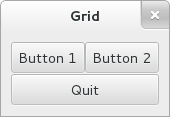- 填充
填充
当创建一个应用时,你将会想将多个控件放入一个窗口控件。我们的第一个 helloworld 范例仅仅使用了一个控件,因而我们可以只是简单地调用一个gtk_container_add()将控件填充到一个窗口控件。但是当你想要向窗口控件中放置超过一个控件时,控制每一个控件的位置和大小就变得很重要了。这就是接下来要讲的填充。
GTK+自带了大量各种布局的容器,这些容器的目的是控制被添加到他们的子控件的布局。具体可以参考布局容器的概述。
下面的示例显示了GtkGrid容器如何让你如何安排几个按钮:

Example 2. Packing buttons
新建一个名为 example-2.c 的文件,写入如下内容:
#include <gtk/gtk.h>static voidprint_hello (GtkWidget *widget,gpointer data){g_print ("Hello World\n");}int main (int argc, char *argv[]){GtkWidget *window;GtkWidget *grid;GtkWidget *button;/* This is called in all GTK applications. Arguments are parsed* from the command line and are returned to the application.*/gtk_init (&argc, &argv);/* create a new window, and set its title */window = gtk_window_new (GTK_WINDOW_TOPLEVEL);gtk_window_set_title (GTK_WINDOW (window), "Grid");g_signal_connect (window, "destroy", G_CALLBACK (gtk_main_quit), NULL);gtk_container_set_border_width (GTK_CONTAINER (window), 10);/* Here we construct the container that is going pack our buttons */grid = gtk_grid_new ();/* Pack the container in the window */gtk_container_add (GTK_CONTAINER (window), grid);button = gtk_button_new_with_label ("Button 1");g_signal_connect (button, "clicked", G_CALLBACK (print_hello), NULL);/* Place the first button in the grid cell (0, 0), and make it fill* just 1 cell horizontally and vertically (ie no spanning)*/gtk_grid_attach (GTK_GRID (grid), button, 0, 0, 1, 1);button = gtk_button_new_with_label ("Button 2");g_signal_connect (button, "clicked", G_CALLBACK (print_hello), NULL);/* Place the second button in the grid cell (1, 0), and make it fill* just 1 cell horizontally and vertically (ie no spanning)*/gtk_grid_attach (GTK_GRID (grid), button, 1, 0, 1, 1);button = gtk_button_new_with_label ("Quit");g_signal_connect (button, "clicked", G_CALLBACK (gtk_main_quit), NULL);/* Place the Quit button in the grid cell (0, 1), and make it* span 2 columns.*/gtk_grid_attach (GTK_GRID (grid), button, 0, 1, 2, 1);/* Now that we are done packing our widgets, we show them all* in one go, by calling gtk_widget_show_all() on the window.* This call recursively calls gtk_widget_show() on all widgets* that are contained in the window, directly or indirectly.*/gtk_widget_show_all (window);/* All GTK applications must have a gtk_main(). Control ends here* and waits for an event to occur (like a key press or a mouse event),* until gtk_main_quit() is called.*/gtk_main ();return 0;}
然后在终端输入以下命令用GCC编译程序:
gcc `pkg-config --cflags gtk+-3.0` -o example-2 example-2.c `pkg-config --libs gtk+-3.0`
